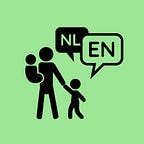Bilingualism and the cultural status of a language
When speaking of bilingualism or multilingualism, many forms and ways are possible. Many aspects can affect a child’s bilingualism, not just how many languages are spoken or in what way the children are introduced. The “choice” of the language itself, and the cultural status of the particular languages in society, can sometimes make a big difference in the chances of a successful bilingual language development. In this blog, I will tell you more about the differences and risks of these cultural aspects of languages, and explain some of the definitions that are used to explain it.
Majority language
A majority language is the language spoken by the majority of the population in any given area. This does not have to be the official language of the country, but can also be a dialect or a much used language within a city or region. However, the majority langue does often refer to the official language of the country. Think of English in the United Kingdom, Dutch in the Netherlands, Turkish in Turkey.
A minority language is a language spoken by a minority of the population in a particular area. This often means a language that is not originally spoken in that area. Examples are Turkish or Dutch in the United Kindom (or USA), and also English in the Netherlands or Turkey. Minority languages can be divided into large minorities and small minorities.
Large minority: In a large minority, you see a relatively large group of people who speak a particular language in an area that otherwise speaks the majority language. Examples of these are the Welsh or Chinese speaking communities in the United Kingdom. The advantage of a large minority is that often the exposure to the language and the accompanying culture in the minority language is widely supported. There are often supermarkets and other shops where the minority language is used, there are many local residents and the language can be heard in playgrounds, for example.
Small minority: In a small minority you often see separate families in which a specific language is spoken. There is no bigger community outside the family that also speaks the language, there are no shops or playgrounds where the language can be heard or read. A child belonging to such a minority often has fewer opportunities to learn the minority language. This doesn’t mean the child cannot learn the language though!
Additive bilingualism
Additive bilingualism is a phenomenon that is seen when the environment of a child (parents, neighbors, school, friends, etc.) has a positive attitude towards all the languages the child is learning. All languages of the child are seen as valuable and are optimally stimulated. You often see this in the majority language, in languages that have a high status, and certainly in languages that are also offered at school. The status of a language can differ per country or region, and tells the the social standing that a language has. In Western countries, other Western languages generally have a higher status (English, French, German, Spanish, etc.). Languages such as Tigrinya, Turkish or dialects have (unfortunately!) a lower status in Western countries. However, Turkish has a high status in Turkey itself. A positive attitude -and with it additive bilingualism- is very important for the (bilingual) language development. In this case, the second or third language is added and learned without compromising the first language or languages the child already has.
Subtractive bilingualism
Subtractive bilingualism occurs when the the environment of a child has a negative attitude towards one or more of the languages that child is learning. This situation often happens in (small) minority languages with a low status. The languages with a higher status are usually stimulated by the environment, but the language with the lower status is not. This subtractive bilingualism can be detrimental to the language development in all languages, but certainly in the minority language. Stimulating the native (or first) language of a child is essential for the further language development of a child. If this is not done sufficiently, the native language can be lost. Because of this loss, problems can arise in the overall language development of the child, which has its (negative) effect on all other languages.
In order to prevent or change subtractive bilingualism, a change in the attitude of the environment is absolutely paramount. Linguistically, no language has a higher status than any other language. Furthermore, it does not matter whether the child learns English, Turkish, Twi, Welsh, Berber languages or sign language for their bilingual development. The benefits of bilingualism are there regardless of the languages used. When this knowledge is present in families as well as school and other places, all of the child’s languages can be stimulated. As described above, the first or native language(s) is the most important to stimulate. This solid language base is necessary to further develop other languages.
Thanks for reading and I’d love to hear what your thoughts are about this topic!
Do you want to know more about bilingualism and the importance of doing it right? Take a look at my other posts on this blog, or follow me on instagram. If you have a specific question about bilingualism in your situation, please let me know! All contact details can be found under contact.
Originally published at https://intentionallybilingual.weebly.com.
